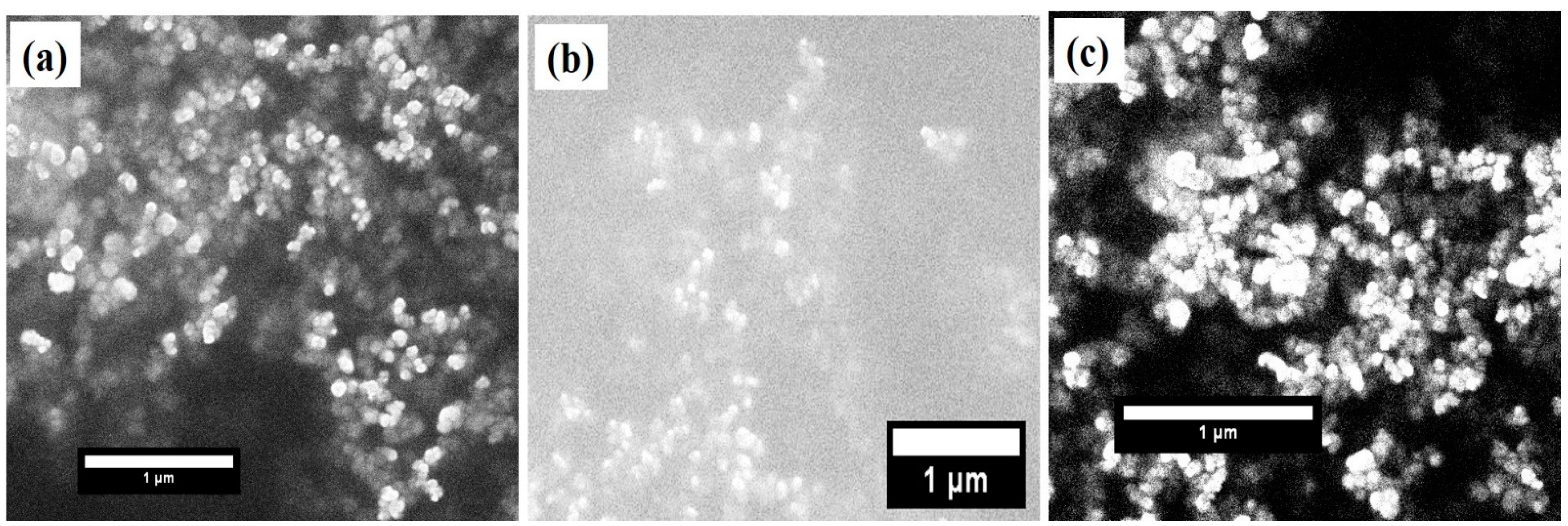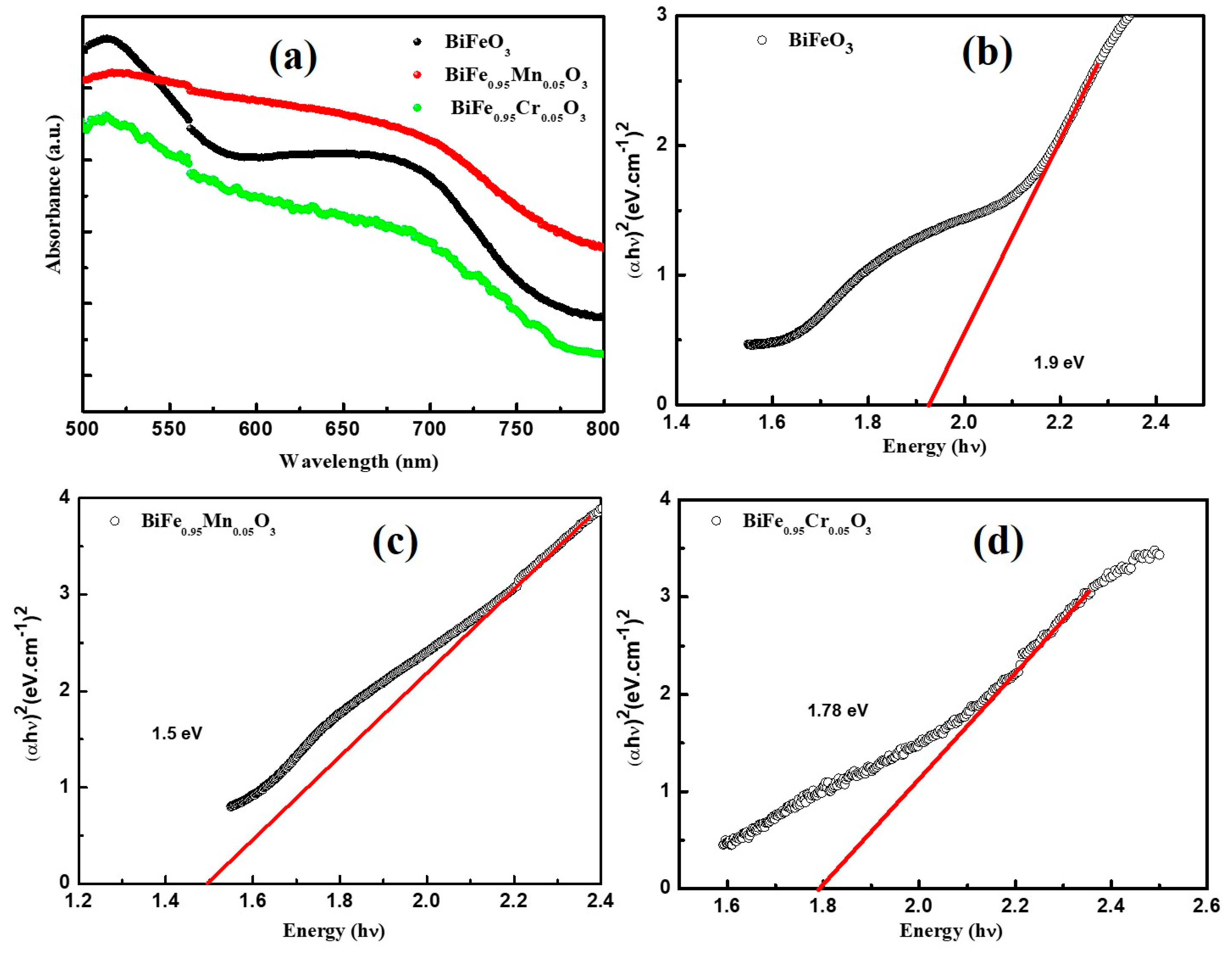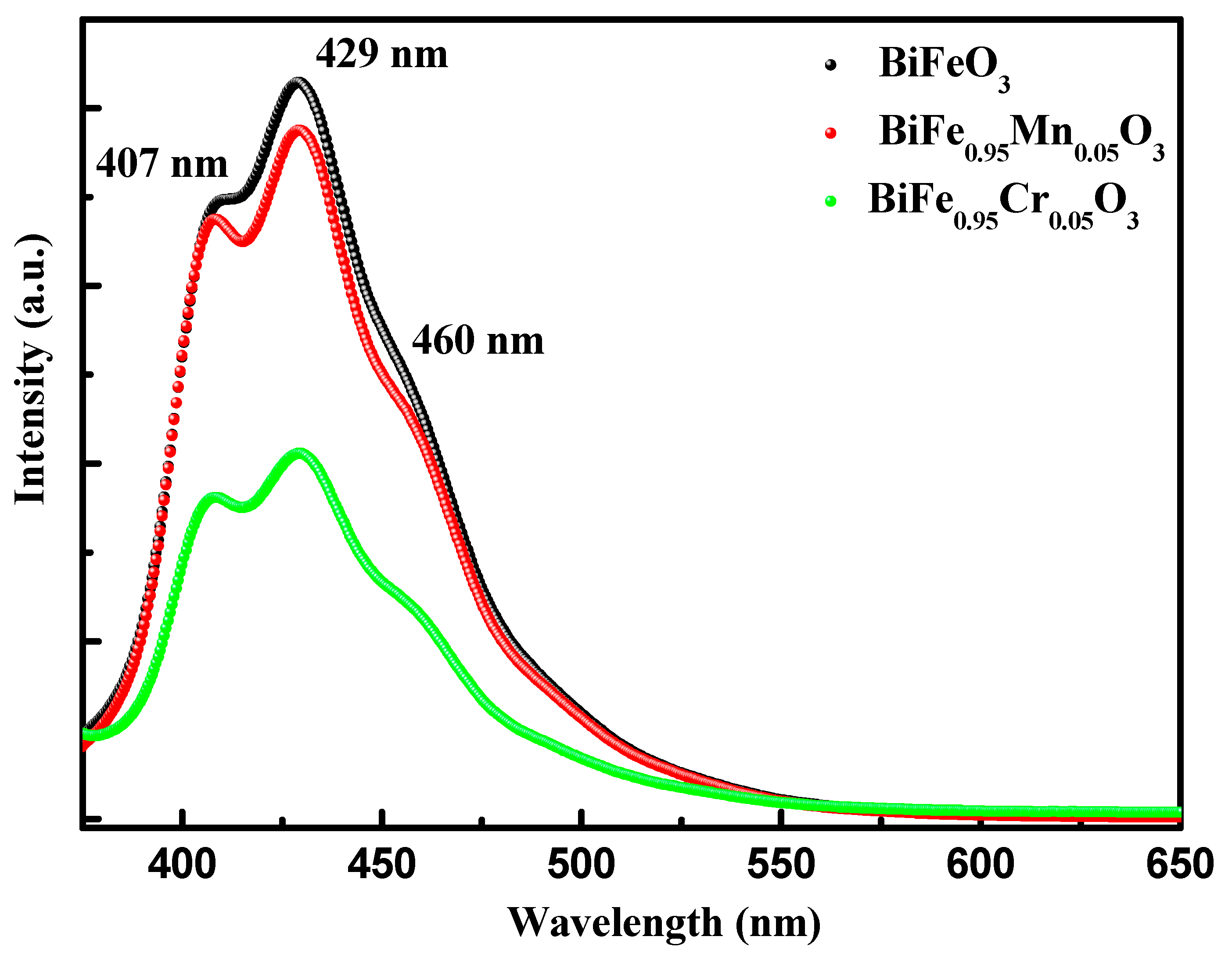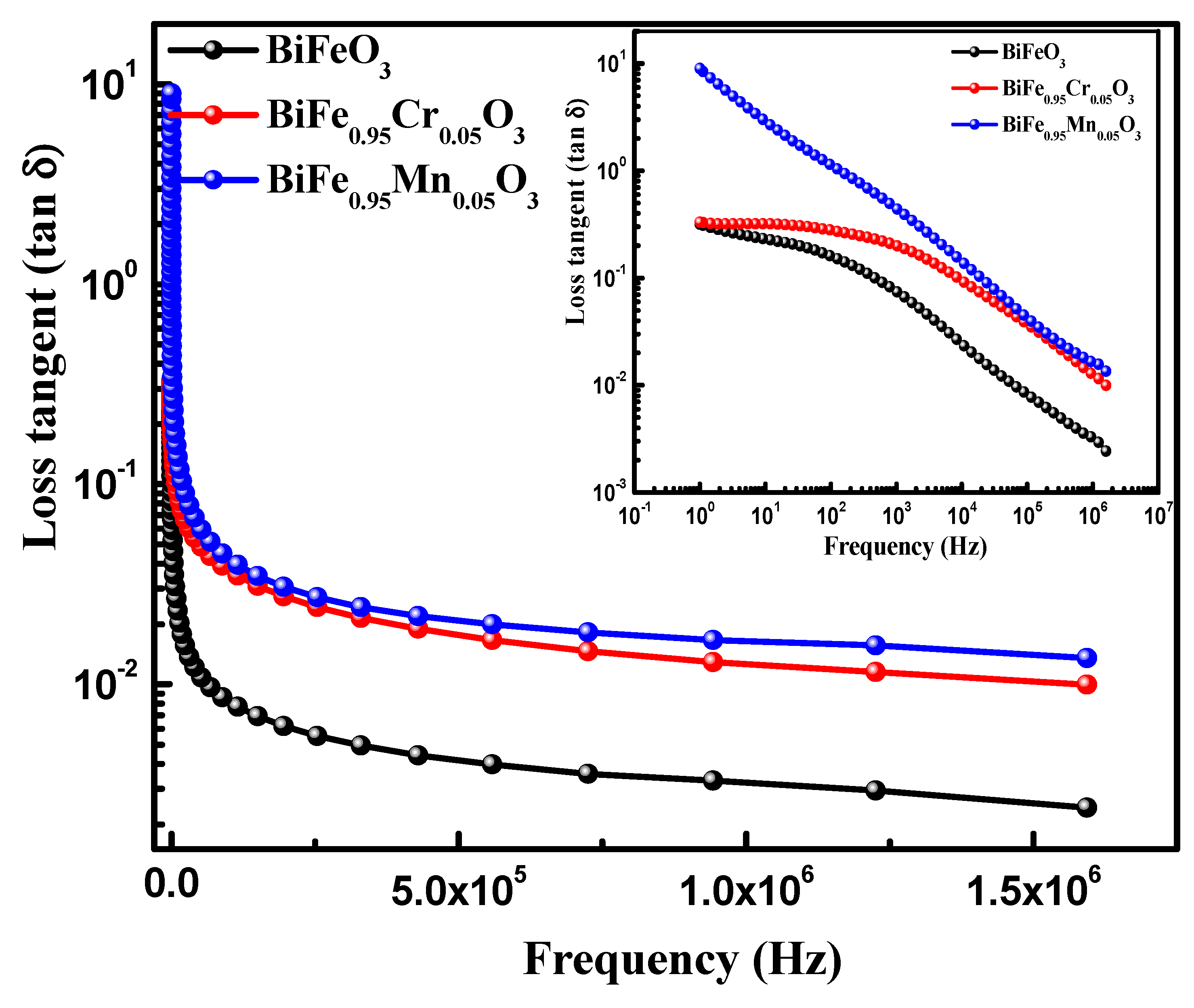Structural, Electrical and Optical Properties of TM (Mn and Cr) Doped BiFeO3 Nanoparticles
Abstract
:1. Introduction
2. Experimental Details
3. Results and Discussion
4. Conclusions
Author Contributions
Funding
Conflicts of Interest
References
- Nogués, J.; Sort, J.; Langlais, V.; Skumryev, V.; Suriñach, S.; Muñoz, J.; Baró, M. Exchange Bias in nanostructures. Phys. Rep. 2005, 422, 65–117. [Google Scholar] [CrossRef]
- Cai, W.; Wan, J. Facile Synthesis of Superparamagnetic Magnetite Nanoparticles in Liquid Polyols. J. Colloid Interface Sci. 2007, 305, 366–370. [Google Scholar] [CrossRef]
- Li, L.; Bi, H.; Gai, S.; He, F.; Gao, P.; Dai, Y.; Zhang, X.; Yang, D.; Zhang, M.; Yang, P. Uniformly Dispersed ZnFe2O4 Nanoparticles on Nitrogen-Modified Graphene for High-Performance Supercapacitor as Electrode. Sci. Rep. 2017, 7, 43116. [Google Scholar] [CrossRef] [Green Version]
- Hashim, M.; Kumar, S.; Shirsath, S.E.; Mohammed, E.M.; Chung, H.; Kumar, R. Studies on the Activation Energy from the Acconductivity Measurements of Rubber Ferrite Composites Containing Manganese Zinc Ferrite. Phys. B Condens. Matter 2012, 407, 4097–4103. [Google Scholar] [CrossRef]
- Sanyal, B.; Kumar, S.; Kumar, M.; Mittal, K.C.; Sharma, A. Alanine-EPR Dosimetry in 10 MeV Electron Beam to Optimize Process Parameters for Food Irradiation. Indian J. Pure Appl. Phys. 2012, 50, 870–873. [Google Scholar]
- Sharma, S.; Kumar, R.; Kumar, S.; Kumar, V.S.; Knobel, M.; Reddy, V.; Banerjee, A.; Singh, M. Magnetic Study of Mg0.95Mn0.05Fe2O4 Ferrite Nanoparticles. Solid State Commun. 2007, 141, 203–208. [Google Scholar] [CrossRef]
- Bric, J.M.; Bostock, R.M.; Silverstone, S.E. Rapid In Situ Assay for Indoleacetic Acid Production by Bacteria Immobilized on a Nitrocellulose Membrane. Appl. Environ. Microbiol. 1991, 57, 535–538. [Google Scholar] [CrossRef] [Green Version]
- Ishida, H.; Ishida, Y.; Kurosaka, Y.; Otani, T.; Sato, K.; Kobayashi, H. In Vitro and In Vivo Activities of Levofloxacin against Biofilm-Producing Pseudomonas Aeruginosa. Antimicrob. Agents Chemother. 1998, 42, 1641–1645. [Google Scholar] [CrossRef] [Green Version]
- Gabrielyan, L.; Hovhannisyan, A.; Gevorgyan, V.; Ananyan, M.; Trchounian, A. Antibacterial Effects of Iron Oxide (Fe3O4) Nanoparticles: Distinguishing Concentration-Dependent Effects with Different Bacterial Cells Growth and Membrane-Associated Mechanisms. Appl. Microbiol. Biotechnol. 2019, 103, 2773–2782. [Google Scholar] [CrossRef]
- Ranmadugala, D.; Ebrahiminezhad, A.; Manley-Harris, M.; Ghasemi, Y.; Berenjian, A. Magnetic Immobilization of Bacteria Using Iron Oxide Nanoparticles. Biotechnol. Lett. 2017, 40, 237–248. [Google Scholar] [CrossRef]
- Collins, D.; Luxton, T.; Kumar, N.; Shah, S.; Walker, V.K.; Shah, V. Assessing the Impact of Copper and Zinc Oxide Nanoparticles on Soil: A Field Study. PLoS ONE 2012, 7, e42663. [Google Scholar] [CrossRef]
- Rajeevan, N.E.; Pradyumnan, P.P.; Kumar, R.; Shukla, D.K.; Kumar, S.; Singh, A.K.; Patnaik, S.; Arora, S.K.; Shvets, I.V. Magnetoelectric Properties of BixCo2−xMnO4 (0 ≤ x ≤ 0.3). Appl. Phys. Lett. 2008, 92, 102910. [Google Scholar] [CrossRef] [Green Version]
- Kumari, S.; Sharma, P.; Yadav, S.; Kumar, J.; Vij, A.; Rawat, P.; Kumar, S.; Sinha, C.; Bhattacharya, J.; Srivastava, C.M.; et al. A Novel Synthesis of the Graphene Oxide-Silver (GO-Ag) Nanocomposite for Unique Physiochemical Applications. ACS Omega 2020, 5, 5041–5047. [Google Scholar] [CrossRef] [Green Version]
- Kim, G.W.; Kumar, S.; Chang, J.; Lee, C.G.; Koo, B.H. Magnetic and Electrical Properties of La0.7Ca0.3Mn0.95Co0.05O3 Epitaxial Layers by Pulsed Laser Deposition. Ceram. Int. 2012, 38, S443–S446. [Google Scholar] [CrossRef]
- Bian, J.L.; Seo, Y.J.; Kim, G.W.; Sung, C.H.; Kumar, S.; Lee, C.G.; Koo, B.H. Magnetoresistance Properties of 0.99La0.7(CaxSr1−x)0.3MnO3/0.01CuZnFe4O4 Composites. Ceram. Int. 2012, 38, S439–S442. [Google Scholar] [CrossRef]
- Kumari, A.; Kumari, K.; Ahmed, F.; Ahmad, M.M.; Sharma, J.; Vij, A.; Kumar, S. Role of Bi-Excess on Structural, Electrical, Optical, and Magnetic Properties BiFeO3 Nanoparticles. J. Mater. Sci. Mater. Electron. 2021, 32, 23968–23982. [Google Scholar] [CrossRef]
- Kumari, A.; Kumari, K.; Ahmed, F.; Alshoaibi, A.; Alvi, P.; Dalela, S.; Ahmad, M.M.; Aljawfi, R.N.; Dua, P.; Vij, A.; et al. Influence of Sm Doping on Structural, Ferroelectric, Electrical, Optical and Magnetic Properties of BaTiO3. Vacuum 2020, 184, 109872. [Google Scholar] [CrossRef]
- Gao, R.; Qin, X.; Wu, H.; Xu, R.; Liu, L.; Wang, Z.; Fu, C.; Cai, W.; Chen, G.; Deng, X. Effect of Ti Doping on the Dielectric, Ferroelectric and Magnetic Properties of Bi0.86La0.08Sm0.14FeO3 Ceramics. Mater. Res. Express 2019, 6, 106317. [Google Scholar] [CrossRef]
- Coondoo, I.; Panwar, N.; Rafiq, M.A.; Puli, V.S.; Katiyar, R.S. Structural, Dielectric and Impedance Spectroscopy Studies in (Bi0.90R0.10)Fe0.95Sc0.05O3 [R = La, Nd] Ceramics. Ceram. Int. 2014, 40, 9895–9902. [Google Scholar] [CrossRef]
- Rao, T.D.; Karthik, T.; Asthana, S. Investigation of Structural, Magnetic and Optical Properties of Rare Earth Substituted Bismuth Ferrite. J. Rare Earths 2013, 31, 370–375. [Google Scholar] [CrossRef] [Green Version]
- Kumar, A.; Varshney, D. Crystal Structure Refinement of Bi1−xNdxFeO3 Multiferroic by the Rietveld Method. Ceram. Int. 2012, 38, 3935–3942. [Google Scholar] [CrossRef]
- Sinha, A.; Bhushan, B.; Jagannath; Sharma, R.; Sen, S.; Mandal, B.; Meena, S.; Bhatt, P.; Prajapat, C.; Priyam, A.; et al. Enhanced Dielectric, Magnetic and Optical Properties of Cr-Doped BiFeO3 Multiferroic Nanoparticles Synthesized by Sol-Gel Route. Results Phys. 2019, 13, 102299. [Google Scholar] [CrossRef]
- Puhan, A.; Nayak, A.; Bhushan, B.; Praharaj, S.; Meena, S.; Rout, D. Enhanced Electrical, Magnetic and Optical Behaviour of Cr doped Bi0.98Ho0.02FeO3 Nanoparticles. J. Alloys Compd. 2019, 796, 229–236. [Google Scholar] [CrossRef]
- Matin, M.; Hossain, M.N.; Ali, A.; Hakim, M.; Islam, M. Enhanced Dielectric Properties of Prospective Bi0.85Gd0.15Fe1−xCrxO3 Multiferroics. Results Phys. 2019, 12, 1653–1659. [Google Scholar] [CrossRef]
- Seidel, J.; Maksymovych, P.; Batra, Y.; Katan, A.; Yang, S.-Y.; He, Q.; Baddorf, A.P.; Kalinin, S.V.; Yang, C.-H.; Yang, J.-C.; et al. Domain Wall Conductivity in La-Doped BiFeO3. Phys. Rev. Lett. 2010, 105, 197603. [Google Scholar] [CrossRef] [Green Version]
- Silva, J.; Reyes, A.; Esparza, H.; Camacho, H.; Fuentes, L. BiFeO3: A Review on Synthesis, Doping and Crystal Structure. Integr. Ferroelectr. 2011, 126, 47–59. [Google Scholar] [CrossRef]
- Spaldin, N.A.; Ramesh, R. Advances in Magnetoelectric Multiferroics. Nat. Mater. 2019, 18, 203–212. [Google Scholar] [CrossRef]
- Lee, C.-C.; Wu, J.-M. Studies on Leakage Mechanisms and Electrical Properties of Doped BiFeO3 Films. Electrochem. Solid-State Lett. 2007, 10, G58–G61. [Google Scholar] [CrossRef]
- Shami, M.Y.; Awan, M.; Anis-Ur-Rehman, M. The Effect of Heat Treatment on Structural and Multiferroic Properties of Phase-Pure BiFeO3. J. Electron. Mater. 2012, 41, 2216–2224. [Google Scholar] [CrossRef]
- Naganuma, H.; Miura, J.; Okamura, S. Ferroelectric, Electrical and Magnetic Properties of Cr, Mn, Co, Ni, Cu Added Polycrystalline BiFeO3 Films. Appl. Phys. Lett. 2008, 93, 052901. [Google Scholar] [CrossRef]
- Shannigrahi, S.R.; Huang, A.; Chandrasekhar, N.; Tripathy, D.; Adeyeye, A.O. Sc Modified Multiferroic BiFeO3 Thin Films Prepared through a Sol-Gel Process. Appl. Phys. Lett. 2007, 90, 022901. [Google Scholar] [CrossRef]
- Hu, G.D.; Cheng, X.; Wu, W.B.; Yang, C.H. Effects of Gd Substitution on Structure and Ferroelectric Properties of BiFeO3 Thin Films Prepared Using Metal Organic Decomposition. Appl. Phys. Lett. 2007, 91, 232909. [Google Scholar] [CrossRef]
- Wang, N.; Luo, X.; Han, L.; Zhang, Z.; Zhang, R.; Olin, H.; Yang, Y. Structure, Performance, and Application of BiFeO3 Nanomaterials. Nano-Micro Lett. 2020, 12, 81. [Google Scholar] [CrossRef] [PubMed] [Green Version]
- Kumar, S.; Srivastava, G.; Almutairi, G.; Ahmed, F.; Shaalan, N.M.; Dalela, S.; Kumar, R.; Kumar, A.P.; Alvi, P.; Chae, K.; et al. Electronic Structure and Electrochemical Properties of La-Doped BiFeO3 Nanoparticles. J. Electron Spectrosc. Relat. Phenom. 2021, 253, 147138. [Google Scholar] [CrossRef]
- Ramachandran, B.; Dixit, A.; Naik, R.; Lawes, G.; Rao, M.S.R. Charge Transfer and Electronic Transitions in polycrystalline BiFeO3. Phys. Rev. B 2010, 82, 012102. [Google Scholar] [CrossRef]
- Hongri, L.; Zuli, L.; Qing, L.; Kailun, Y. Electric and Magnetic Properties of Multiferroic (BiFeO3)1−x–(PbTiO3)x Films Prepared by the Sol–Gel Process. J. Phys. D Appl. Phys. 2006, 39, 1022–1027. [Google Scholar] [CrossRef]
- Zhang, Z.; Wu, P.; Chen, L.; Wang, J. Systematic Variations in Structural and Electronic Properties of BiFeO3 by A-Site Substitution. Appl. Phys. Lett. 2010, 96, 012905. [Google Scholar] [CrossRef]
- Kumari, K.; Aljawfi, R.N.; Chawla, A.; Kumar, R.; Alvi, P.; Alshoaibi, A.; Vij, A.; Ahmed, F.; Abu-Samak, M.; Kumar, S. Engineering the Optical Properties of Cu Doped CeO2 NCs for Application in White LED. Ceram. Int. 2020, 46, 7482–7488. [Google Scholar] [CrossRef]
- Arya, A.; Sharma, A.L. Structural, Electrical Properties and Dielectric Relaxations in Na+-Ion-Conducting Solid Polymer Electrolyte. J. Phys. Condens. Matter 2018, 30, 16. [Google Scholar] [CrossRef]







| Samples | Lattice Parameters (a/c) Å | Crystallite Size (nm) | Strain (×10−3) | χ2 | Band Gap (eV) |
|---|---|---|---|---|---|
| BiFeO3 | 5.5769/13.8656 | 54.4 | 2.27 | 2.5 | 1.90 eV |
| BiFe0.95Mn0.05O3 | 5.5758/13.8568 | 46.4 | 2.44 | 2.0 | 1.50 eV |
| BiFe0.95Cr0.05O3 | 5.5732/13.8478 | 38.7 | 3.68 | 1.9 | 1.78 eV |
Publisher’s Note: MDPI stays neutral with regard to jurisdictional claims in published maps and institutional affiliations. |
© 2022 by the authors. Licensee MDPI, Basel, Switzerland. This article is an open access article distributed under the terms and conditions of the Creative Commons Attribution (CC BY) license (https://creativecommons.org/licenses/by/4.0/).
Share and Cite
Taisan, N.A.; Kumar, S.; Alshoaibi, A. Structural, Electrical and Optical Properties of TM (Mn and Cr) Doped BiFeO3 Nanoparticles. Crystals 2022, 12, 1610. https://doi.org/10.3390/cryst12111610
Taisan NA, Kumar S, Alshoaibi A. Structural, Electrical and Optical Properties of TM (Mn and Cr) Doped BiFeO3 Nanoparticles. Crystals. 2022; 12(11):1610. https://doi.org/10.3390/cryst12111610
Chicago/Turabian StyleTaisan, Nada Al, Shalendra Kumar, and Adil Alshoaibi. 2022. "Structural, Electrical and Optical Properties of TM (Mn and Cr) Doped BiFeO3 Nanoparticles" Crystals 12, no. 11: 1610. https://doi.org/10.3390/cryst12111610








